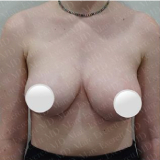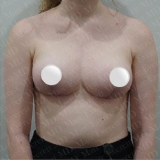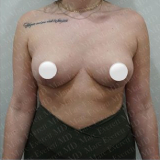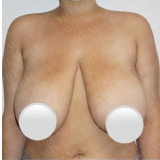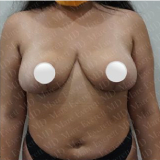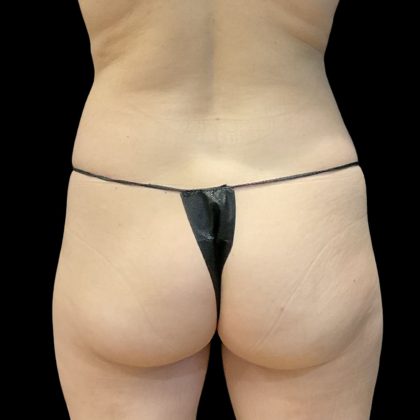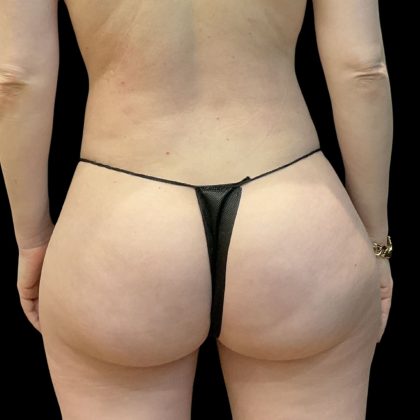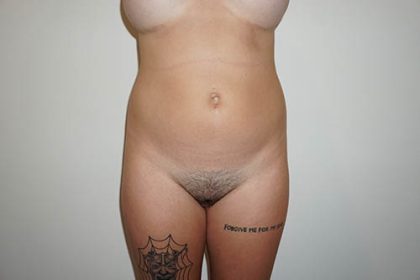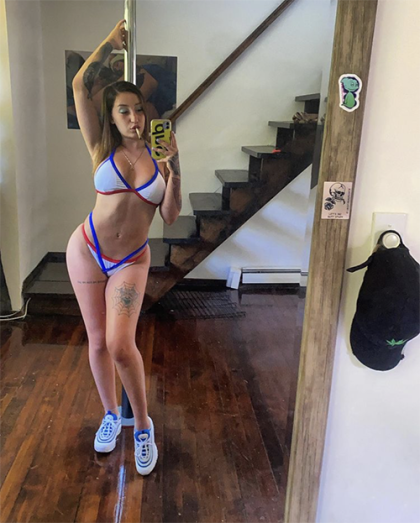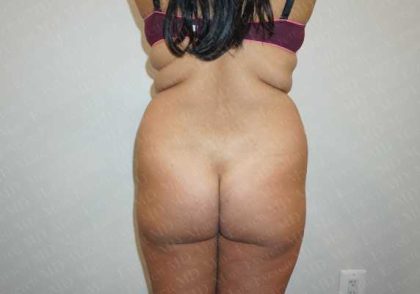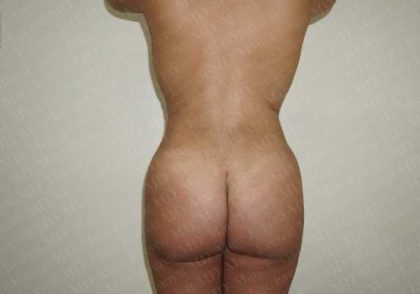Brazilian Butt Lift
Consultations offered at our two convenient locations in Manhattan, NY and Queens, NY
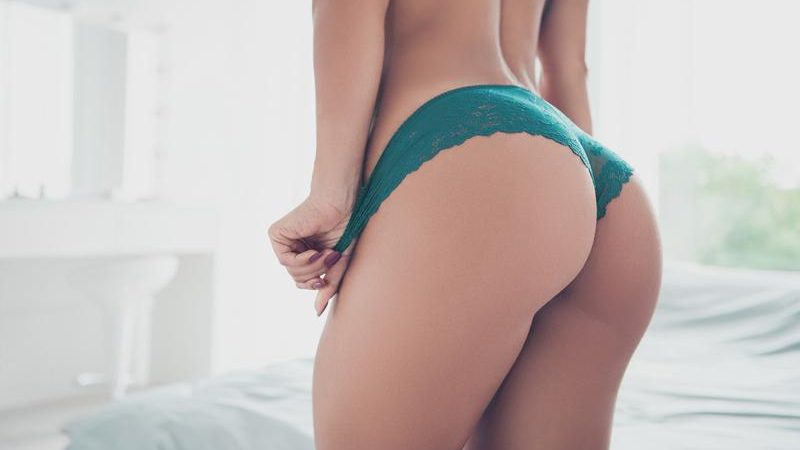
A Brazilian butt lift (BBL) is a surgical procedure that augments the size and shape of a patient’s buttocks using fat taken from elsewhere in the body using liposuction. Some patients may choose to combine this with Renuvion, the latest and most effective skin-tightening technology. A BBL provides natural-looking results because it uses natural means to achieve a more aesthetically pleasing shape. Surgeons commonly harvest fat from the sides and abdomen to create a slimmer waistline and hourglass-like figure that complements the more youthful, curvier buttocks. When they reintroduce this fat back into the buttocks, it grafts permanently and continues to thrive in its new location.
If you are unhappy with the shape or size of your buttocks, or the proportion of your hips and butt to your waist, and are also interested in the fat loss benefits of liposuction, visit our office to receive a personalized BBL procedure. Renowned NY body-contouring surgeon Dr. Marc Everett will help you achieve your ideal curves without using synthetic fillers or implants.
To book your consultation appointment today, call The Everett Clinic at (212) 774-7715 to reach his locations in Manhattan or Queens, or fill out his contact form, and someone will be in touch with you shortly.
Before and After Photos
Contents
- 1 Before and After Photos
- 2 About the BBL
- 3 Are BBLs Safe?
- 4 Who is a Good Candidate for a BBL?
- 5 Personal Consultation
- 6 Procedure Steps
- 7 Recovery and Results
- 8 Cost of a BBL in New York City
- 9 FAQ
- 9.1 How soon after a BBL procedure can I go swimming or take a shower?
- 9.2 How long before I can exercise again after BBL surgery?
- 9.3 Will I have noticeable scars after a BBL?
- 9.4 How much of the added fat will be absorbed by the body?
- 9.5 How long does the procedure take?
- 9.6 How long do results from a BBL last?
- 9.7 If don’t have enough fat to transfer for a BBL, can I use someone else’s?
- 10 References
About the BBL
A BBL can improve the balance and proportion between the buttocks, hips, waist, and thighs. A common misconception is that the BBL is only popular among celebrities and influencers, but the research states otherwise. Within just the past 10 years, the popularity of the procedure has risen by about 61%. (1) With a Brazilian butt lift, patients can not only add natural-looking, even volume throughout the buttock area, but they can also slim down bulges where stubborn fat may remain. Common donor sites include the abdomen, sides, thighs, and back. Dr. Everett was featured in the Daily Mail about the latest trends and how patient goals for their hips, waist, and buttocks have changed over the years.
Dr. Everett applies advanced liposuction techniques, creating tiny incisions to access the fat just under the skin. He then utilizes a tube-like instrument called a cannula to harvest the donor fat deposits safely and effectively. He strategically reinjects the donor fat into the buttocks to provide more projected and rounder contours. Patients can then sustain this enhancement by carefully following recovery instructions and maintaining their weight throughout the years following the procedure.
Are BBLs Safe?
Since becoming much more well-known and widespread within celebrity culture, many prospective patients have questions about the safety of the BBL. In recent years, clearer, more stringent surgical guidelines have helped surgeons significantly reduce the chance of causing a complication. Dr. Everett’s fellowship thesis entitled “Safest Practices for Autologous Buttock Augmentation With Fat Grafting Using a Roller Pump Injection Technique” was a landmark publication outlining how to set up and perform the popularized procedure as well as a series of safety principles derived from their experience accruing, at the time, the largest number of patients to have ever been published in the literature. (2)
The publication came with a strict set of recommendations for surgeons to adhere to in order to perform the operation safely. Dr. Everett remains at the forefront of the pursuit to advance knowledge that keeps patients safe. Surgeons are keen to remain updated on the latest research to direct their procedures. For one, Dr. Everett recommends that all surgeons performing BBLs use only specific cannula types and insert the cannula at a highly specific angle, minimizing the possibility of entering into and injecting fat into the wrong place, which may lead to dangerous outcomes. Many other protocols improve BBL results for patients looking to attain the voluptuous, hourglass look that is so highly sought-after.
Who is a Good Candidate for a BBL?
BBL candidates desire an increase in buttock volume and improved shape. To be eligible for the procedure, patients must have pockets of fat located elsewhere in the body that can provide the donor fat necessary to augment the buttocks. Prospective patients must also be healthy individuals who are within 25 pounds of their ideal body weight. Liposuction is a fat removal procedure, not weight loss surgery, and is for patients who have seen unsuccessful results from a healthy diet and regular exercise.
Personal Consultation
Dr. Marc Everett offers BBL procedures to his patients to help them build their ideal figure.
During your consultation, he will happily discuss all aspects of the BBL procedure with you in detail to formulate a procedure plan that will leave you feeling more body confident than ever before. If you are frustrated with stubborn pockets of fat that diet and exercise cannot seem to eliminate and would like a perkier and more uplifted rear, then visit one of Dr. Everett’s offices in Manhattan or Queens for a BBL consultation. Call us today at (212) 774-7715 or submit this online form to get started.
Procedure Steps
While you are under general anesthesia, Dr. Everett will perform the BBL procedure in two steps: liposuction and fat grafting. He will make small incisions in the donor area to allow for the insertion of the cannula, a thin metal tube with a blunt end. He will then administer tumescent fluid, a solution that engorges the fat cells and helps them separate from fibrous tissue and skin. This solution will also prevent significant blood loss by constricting blood vessels in the treatment area. He will then move the cannula in a back-and-forth motion to loosen fat before drawing it out using suction. If needed, skin tightening would be performed at the end of the liposuction phase.
After the fat harvesting stage, Dr. Everett will purify it to ensure that only the most viable fat cells are used for the grafting portion of the procedure. He will remove more fat than is needed to provide enough high-quality cells, so he will contour additional sections of the body at the patient’s request. Harvesting more than is required is important to create the most desirable results since about 70% of the injected fat survives permanently. (3)
Once Dr. Everett removes and purifies an adequate amount of fat, he will then gradually and strategically inject it into the buttocks to add volume. He will inject this fat in multiple sites and angles to create an even shape and harmonious symmetry.
Recovery and Results
After a BBL procedure, patients should expect to spend two to three weeks recovering before resuming most of their normal activities. They will need to schedule one week off from work to allow appropriate time for the body to heal. Direct pressure on the buttocks can initially shift the fat grafting from the intended location (4) and over time will limit the survival of the transplanted fat cells which will harm the results, so patients will need to avoid sitting down and sleeping on their backs for the first two weeks. For weeks three and four, you may put pressure on the buttocks for 45-60 minutes at a time every 4 hours, which makes it easier to commute to and from work and to sit for meals. Dr. Everett will require that you wear a compression garment for this period as well, to help compress the lymphatic space of the lipo-treated areas.
Common side effects include bruising, numbness, swelling, soreness, and general discomfort. Discomfort and bruising will gradually improve over the first couple of weeks of recovery. Numbness in the targeted area can linger for a few weeks to several months.
Dr. Everett will remove any non-dissolvable sutures or surgical drains in seven to ten days.
Results will be immediately visible with the body contouring effects of the liposuction and the added volume of the buttocks augmentation. However, residual swelling can distort the patient’s new proportions for up to six months. Results will continue to develop as the body accepts the fat grafts and absorbs any excess fat and fluids. Final results are typically visible in three to four months.
Cost of a BBL in New York City
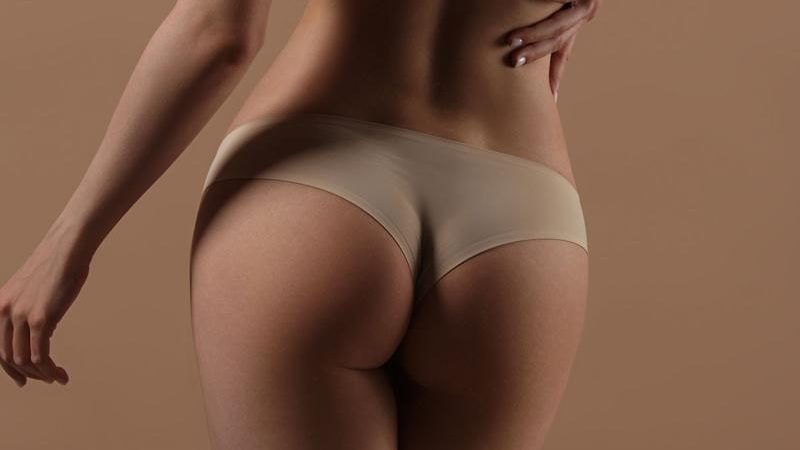
The cost of your BBL will depend on various factors that contribute to the extent of the procedure, mainly the extent and location of areas to be treated with liposuction and whether there is the need for skin-tightening technology such as Renuvion in order to optimize the result of the liposuction. Dr. Everett will provide the total cost estimate associated with your surgery and any follow-up appointment fees during your consultation.
If you are curious to learn more or would like to find out if you are an eligible candidate for this transformative procedure, call (212) 774-7715 or inquire using Dr. Everett’s online form. To explore more options at The Everett Clinic, you can visit our blog.
FAQ
How soon after a BBL procedure can I go swimming or take a shower?
You can shower the day after your procedure, even if your incisions were left open for drainage, although you must avoid submerging your body in still water. Most patients can swim or take a bath around two weeks following their procedure.
How long before I can exercise again after BBL surgery?
Patients undergoing a BBL procedure will need to be prepared to devote at least a few days of rest to promote a healthy and successful recovery. Most patients can resume their normal activities after a few weeks, but some may find they need more time before they feel comfortable returning to exercise and more strenuous activities. We will discuss your expected recovery timeline in detail before your procedure, as well as evaluate the status of your recovery during regular post-op appointments.
Will I have noticeable scars after a BBL?
Liposuction uses very small incisions to allow for the insertion of the cannula. You should expect to have some minimal scars, although they will be less than a quarter-inch in length and mostly unnoticeable. Any scarring will continue to mature and fade for 12 to 18 months, at which point they will become very thin and pale.
How much of the added fat will be absorbed by the body?
The amount of usable fat will be affected by the purification process, as only the highest quality fat that provides the best chance of a successful graft will be chosen. Around 50% to 80% of the transplanted fat will receive a proper blood supply and remain after three months, while the body will safely absorb any excess fat. To compensate for this expected fat loss, surgeons will add extra volume to anticipate any shrinkage that occurs over the first few months.
How long does the procedure take?
The BBL is a highly customizable procedure that can vary in length depending on the amount of liposuction the patient would like done and how much volume they want to be added to their buttocks. Most procedures are between two and five hours in duration.
How long do results from a BBL last?
Results will mostly stabilize about three months after the procedure. Patients will need to maintain a stable body weight following their procedure to preserve their new proportions. Liposuction directly removes fat from the targeted areas, but it does not prevent new fat cells from developing due to an unhealthy lifestyle. Your new contours should last as long as you continue to live healthily.
If don’t have enough fat to transfer for a BBL, can I use someone else’s?
Not everyone has the extra fat needed for a traditional Brazilian Butt Lift, but now these patients have a new treatment option thanks to AlloClae from Tiger Aesthetics. This donated, processed fat filler is a revolutionary way to achieve your BBL goals, no fat harvesting required.
Injected under local anesthesia, AlloClae adds volume, sculpts your curves, and encourages your body to build more of its own tissue over time.
References
- O’Neill RC, Abu-Ghname A, Davis MJ, Chamata E, Rammos CK, Winocour SJ. The Role of Fat Grafting in Buttock Augmentation. Semin Plast Surg. 2020;34(1):38-46. doi:10.1055/s-0039-3401038
- Everett M, Morales R, Newall G, et al. Safest Practices for Autologous Buttock Augmentation With Fat Grafting Using a Roller Pump Injection Technique. Aesthetic Surgery Journal. 2017;38(7):751-762. doi:https://doi.org/10.1093/asj/sjx113
- Serbülent Güzey, Ayça Ergan Şahin. Brazilian Butt Lift: An Experience Over 3000 Patients. Aesthetic plastic surgery. Published online April 5, 2024. doi:https://doi.org/10.1007/s00266-024-03965-8
- Wall S, Delvecchio D, Teitelbaum S, et al. Subcutaneous Migration. Plastic and Reconstructive Surgery. 2019;143(5):1343-1351. doi:https://doi.org/10.1097/prs.0000000000005521








